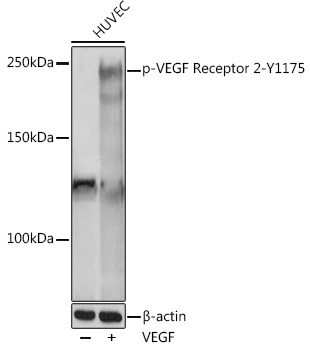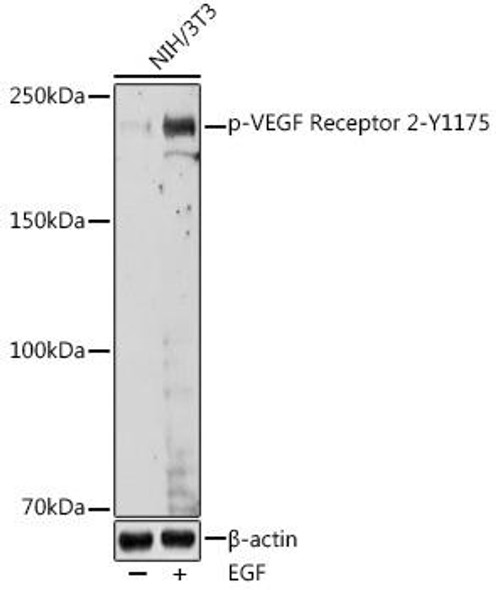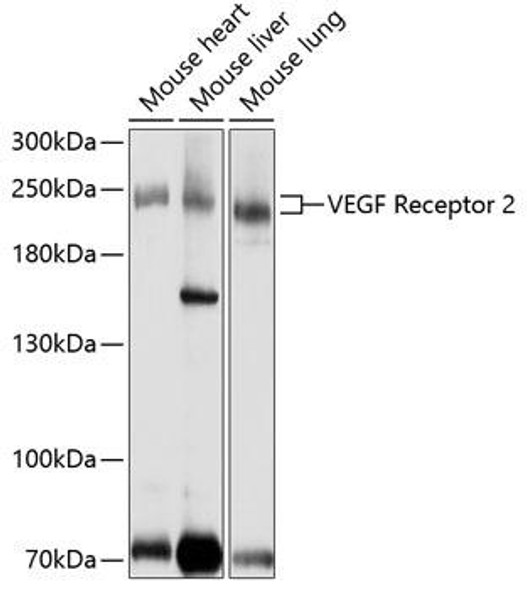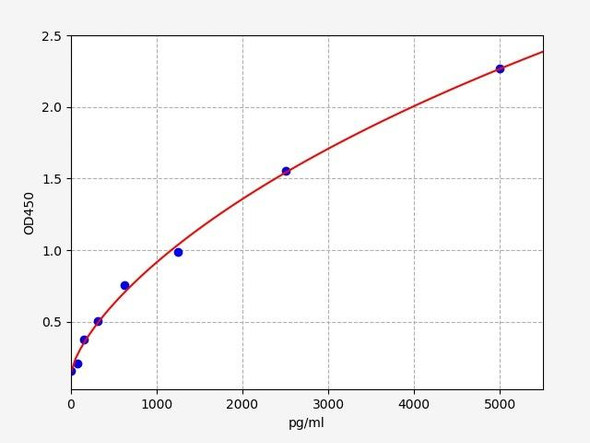Description
Anti-Phospho-VEGF Receptor 2-Y1175 Antibody (CABP1095)
The Phospho-VEGF Receptor 2 (Y1175) Rabbit Polyclonal Antibody (CABP1095) is a valuable tool for researchers studying vascular endothelial growth factor receptor 2 (VEGFR2) signaling pathways. This antibody, generated in rabbits, is highly specific and reactive with human samples, making it ideal for use in Western blot applications. VEGFR2 plays a key role in angiogenesis, the process by which new blood vessels form from existing vessels. Phosphorylation of tyrosine 1175 on VEGFR2 is known to be crucial for its activation and downstream signaling, making it a critical target for investigation in cancer research, cardiovascular diseases, and other conditions involving abnormal blood vessel growth.
By enabling the detection and analysis of phosphorylated VEGFR2 at Y1175, this antibody allows researchers to gain insights into the mechanisms governing angiogenesis and explore potential therapeutic strategies targeting this pathway. Its application in various cell types makes it a versatile tool for studies aimed at understanding the role of VEGFR2 signaling in health and disease.
| Antibody Name: | Anti-Phospho-VEGF Receptor 2-Y1175 Antibody |
| Antibody SKU: | CABP1095 |
| Antibody Size: | 20uL, 50uL, 100uL |
| Application: | WB |
| Reactivity: | Human, Mouse, Rat |
| Host Species: | Rabbit |
| Immunogen: | A phospho specific peptide corresponding to residues surrounding Y1175 of human VEGF Receptor 2. |
| Application: | WB |
| Recommended Dilution: | WB 1:500 - 1:2000 |
| Reactivity: | Human, Mouse, Rat |
| Positive Samples: | HUVEC |
| Immunogen: | A phospho specific peptide corresponding to residues surrounding Y1175 of human VEGF Receptor 2. |
| Purification Method: | Affinity purification |
| Storage Buffer: | Store at -20°C. Avoid freeze / thaw cycles. Buffer: PBS with 0.02% sodium azide, 50% glycerol, pH7.3. |
| Isotype: | IgG |
| Sequence: | Email for sequence |
| Gene ID: | 3791 |
| Uniprot: | P35968 |
| Cellular Location: | Cell junction, Cell membrane, Cytoplasm, Cytoplasmic vesicle, Early endosome, Endoplasmic reticulum, Nucleus, Secreted, Single-pass type I membrane protein |
| Calculated MW: | 75kDa/79kDa/151kDa |
| Observed MW: | 230KDa |
| Synonyms: | CD309, FLK1, VEGFR, VEGFR2, VEGF Receptor 2, KDR |
| Background: | Vascular endothelial growth factor (VEGF) is a major growth factor for endothelial cells. This gene encodes one of the two receptors of the VEGF. This receptor, known as kinase insert domain receptor, is a type III receptor tyrosine kinase. It functions as the main mediator of VEGF-induced endothelial proliferation, survival, migration, tubular morphogenesis and sprouting. The signalling and trafficking of this receptor are regulated by multiple factors, including Rab GTPase, P2Y purine nucleotide receptor, integrin alphaVbeta3, T-cell protein tyrosine phosphatase, etc.. Mutations of this gene are implicated in infantile capillary hemangiomas. [provided by RefSeq, May 2009] |
| UniProt Protein Function: | VEGFR2: a receptor tyrosine kinase of the VEGFR family. High affinity receptor for VEGF and VEGF-C. Ligand binding induces autophosphorylation and activation. Activated receptor recruits proteins including Shc, GRB2, PI3K, Nck, SHP-1 and SHP-2. Plays a key role in vascular development and regulation of vascular permeability. |
| UniProt Protein Details: | Protein type:Protein kinase, TK; Kinase, protein; Membrane protein, integral; EC 2.7.10.1; Protein kinase, tyrosine (receptor); TK group; VEGFR family Chromosomal Location of Human Ortholog: 4q11-q12 Cellular Component: Golgi apparatus; endoplasmic reticulum; integral to plasma membrane; early endosome; cytoplasmic membrane-bound vesicle; extracellular region; plasma membrane; cell junction; nucleus; endosome; lipid raft; external side of plasma membrane Molecular Function:integrin binding; vascular endothelial growth factor receptor activity; protein binding; growth factor binding; protein-tyrosine kinase activity; receptor signaling protein tyrosine kinase activity; Hsp90 protein binding; transmembrane receptor protein tyrosine kinase activity; ATP binding Biological Process: extracellular matrix organization and biogenesis; positive regulation of positive chemotaxis; peptidyl-tyrosine phosphorylation; viral reproduction; protein amino acid autophosphorylation; cell maturation; calcium ion homeostasis; regulation of cell shape; positive regulation of MAPKKK cascade; positive regulation of focal adhesion formation; ovarian follicle development; positive regulation of cell proliferation; positive regulation of mesenchymal cell proliferation; angiogenesis; vasculogenesis; endothelial cell differentiation; cell fate commitment; embryonic hemopoiesis; positive regulation of phosphoinositide 3-kinase cascade; positive regulation of angiogenesis; cell migration during sprouting angiogenesis; branching morphogenesis of a tube; positive regulation of endothelial cell proliferation; positive regulation of protein amino acid phosphorylation; lymph vessel development; vascular endothelial growth factor receptor signaling pathway; alveolus development; surfactant homeostasis; transmembrane receptor protein tyrosine kinase signaling pathway; negative regulation of apoptosis; positive regulation of cell migration; positive regulation of nitric-oxide synthase biosynthetic process Disease: Hemangioma, Capillary Infantile |
| NCBI Summary: | Vascular endothelial growth factor (VEGF) is a major growth factor for endothelial cells. This gene encodes one of the two receptors of the VEGF. This receptor, known as kinase insert domain receptor, is a type III receptor tyrosine kinase. It functions as the main mediator of VEGF-induced endothelial proliferation, survival, migration, tubular morphogenesis and sprouting. The signalling and trafficking of this receptor are regulated by multiple factors, including Rab GTPase, P2Y purine nucleotide receptor, integrin alphaVbeta3, T-cell protein tyrosine phosphatase, etc.. Mutations of this gene are implicated in infantile capillary hemangiomas. [provided by RefSeq, May 2009] |
| UniProt Code: | P35968 |
| NCBI GenInfo Identifier: | 9087218 |
| NCBI Gene ID: | 3791 |
| NCBI Accession: | P35968.2 |
| UniProt Secondary Accession: | P35968,O60723, Q14178, A2RRS0, B5A925, C5IFA0, |
| UniProt Related Accession: | P35968 |
| Molecular Weight: | 79,634 Da |
| NCBI Full Name: | Vascular endothelial growth factor receptor 2 |
| NCBI Synonym Full Names: | kinase insert domain receptor (a type III receptor tyrosine kinase) |
| NCBI Official Symbol: | KDR |
| NCBI Official Synonym Symbols: | FLK1; CD309; VEGFR; VEGFR2 |
| NCBI Protein Information: | vascular endothelial growth factor receptor 2; soluble VEGFR2; fetal liver kinase 1; fetal liver kinase-1; protein-tyrosine kinase receptor Flk-1; tyrosine kinase growth factor receptor |
| UniProt Protein Name: | Vascular endothelial growth factor receptor 2 |
| UniProt Synonym Protein Names: | Fetal liver kinase 1; FLK-1; Kinase insert domain receptor; KDR; Protein-tyrosine kinase receptor flk-1; CD_antigen: CD309 |
| Protein Family: | Vascular endothelial growth factor receptor |
| UniProt Gene Name: | KDR |
| UniProt Entry Name: | VGFR2_HUMAN |










